The Cutting Edge
Defining a new role for digital technology in the restoration of historic woodwork
Matt Bateman and Greg Meeson
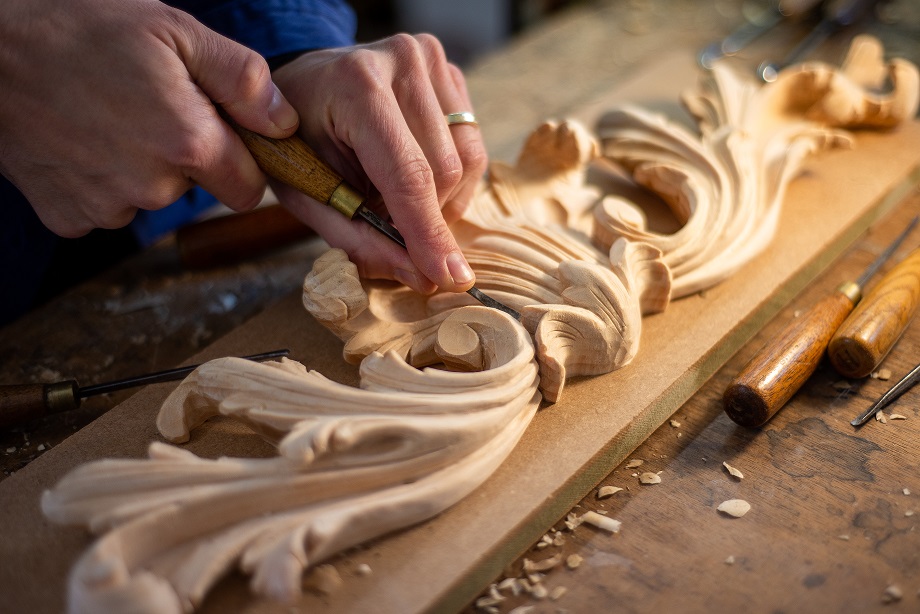
Traditional hand carving by Refinery’s Matt Bateman (all images © Refinery Works LLP)
The explosion of new digital technologies and their increased accessibility over the past decade have enabled a revolution in manufacturing and production.
3D scanning, 3D printing and CNC machining have brought about radical new possibilities heralding a new era of rapid prototyping and accelerated product development.
Many of these technologies have found their place within conservation practice, bringing new ways of working that are more efficient or expansive.
In surveying, digital scanning and photogrammetry have enabled highly effective workflows that capture site data on a level previously unimaginable, proving invaluable for assessing the need for conservation work, communicating the work required and recording the state of a building or component at a point in time.
But in physical restoration work it has been less clear how these capabilities can bring substantial improvement without detriment. Unlike surveying, for example, where modern technology contributes significantly without leaving any trace of its use, physical interventions will impact on the project’s historic authenticity.
As a result, the repair of historic features still largely relies on traditional process, authentic materials and fine craftsmanship. Newly produced pieces have to sit alongside or be embedded within the historic originals being preserved, so they must have the same depth of character and their form must speak of the craft processes that produced them.
So, finding a home for digital technology in these historic methods of production is perhaps not as straightforward as in other areas of conservation.
3D printing’s extruded plastic forms, for example, have certainly found use in model making and visualisation, but have seemingly little or no role to play in restoring, or repairing historic features.
While it can generate form, its extruded synthetic structures offer nothing to a process seeking authenticity and historic validity. With CNC, however, we have seen some interesting developments recently.
CNC and its limitations
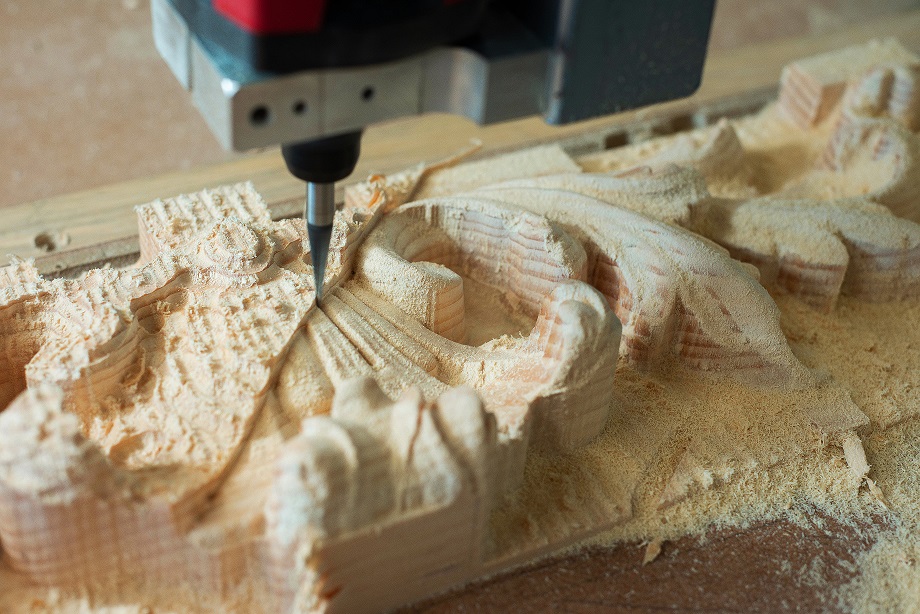
CNC cutting of timber to reveal a ‘near-form’, ready for hand carving
In CNC machining (the letters stand for ‘computerized numerical control’), material is accurately removed by a cutter which is positioned and moved in two or three dimensions automatically, following digital co-ordinates defined using CAD software.
The process has become common in modern furniture design where it plays a valuable role as a fast, but heavily compromised alternative to traditional hand carving. Features are soft and undefined, and the organic quality of hand craftsmanship is entirely lost.
As such, features formed by CNC alone are rightly viewed as a heavy compromise, sacrificing significant quality for savings in time and budget.
With traditional handcraftsmanship and historic process absolutely vital to authentic and successful historic restoration, it might appear that digital process has no role to play in conservation production. Yet, with a fresh perspective, new approaches can harness the best of both worlds.
Digitally driven CNC can bring great efficiency and accuracy to the organised removal of bulk material, taking timber down to a near-finished form, ready for traditional hand carving to find the final surface.
This highly accurate and repeatable method of voiding unwanted material leaves craftspeople free to focus their skills on carving the final surface, finding the crisp final form, full of the visual language of hand-carved wood.
In many ways this process mirrors a traditional team of assistants, working through the same lengthy processes of reduction before handing over to the master craftsperson for the most skilful final stages.
Equally, it can be seen as a logical continuation of the use of mechanised tools in the assist with voiding bulk material. Craftspeople have always used whatever technology was available to them to aid them in their work.
From the pre- industrial harnessing of water power to drive sawmills, to the introduction of electric routers, bandsaws and planers, our reliance on hand tools alone has slowly diminished, enabling faster conversion, voiding and preparation of material.
CNC can simply be seen as another development in the tools crafts people use to better facilitate their craft.
It is perhaps time for the modern conservation workshop to embrace and value digital technology for what it can add to a project when used with consideration and partnered with skilled craft.
From a craftsperson’s perspective, utilising digital technology in this way removes multiple stages of effort, previously necessary to prepare block timber for carving in fine surface detail.
It gets the craftsperson to the fine detail stages much more quickly. It avoids wasting energy and stamina on the roughing out phases, while preserving the strength and concentration for where it is most required: the final hand carved detail.
In a modern world where traditional process is increasingly too costly and time consuming to be a viable option in projects, there is great value in that.
Other Benefits of Dual
While this ‘behind-the-scenes’ use of CNC cutting is worthwhile enough on its own, the digital process that powers it has numerous other capabilities and advantages.

Digital scan of original wood carving detail.
Minimising intervention
3D scanning and digital production is ideally suited to the repair and restoration of damage where the original form of the missing material can be determined, as it enables the creation of exact copies of missing areas.
In conventional restoration work, the process typically requires the removal of even more original timber to form a clean interface between old and new.
While this approach may make the repair easier to execute, it takes away material that would ideally be conserved. Digital 3D scanning enables the capture of even the most complex interfaces with incredible accuracy, enabling the CNC cutting of timber to form an exact counterpart to the damaged surface.
Consequently, areas of damage can be restored to a complete design in a matching timber, while minimising the need to cut away existing material.
Digital modelling
With a digital core at the heart of the production process, a wealth of new options become possible. Digital 3D scanning provides data which can be used to create a 3D digital counterpart to the proposed real word artefact.
This digital model enables inspection and examination of projects at a very early stage. Before a single piece of wood is even cut, the project can be viewed and appraised in great detail.
Photo-real CGI visualisations can be made, along with scale-accurate 3D printed models and drawings, to enable thorough inspection of the planned production process.
This ability to share and discuss at this early stage brings the opportunity to adapt and fine tune planned works, ensuring a successful outcome.
Importantly, it removes uncertainty and the risk of expensive alterations mid-build, promoting peace of mind and confidence in a mutual understanding of the project’s outcomes.
With a digital workflow comes certainty. Timings for the creation of even the most ornate features become a known quantity. The ever-present danger of projects costing more and taking longer are greatly reduced.
Scanning as safeguarding
In addition to its role in restorative repair work, the 3D digital model is also a valuable tool for safeguarding against future damage.
By making a detailed scan of the full surface of an item, a digital safeguard is created that can then facilitate authentic replication and repair.
It can be used to produce an accurate record of the historical architectural detail of a building and its features. This archive can serve as a reference in the event of accident or and also becomes a valuable asset for other uses such as education and research.
The scanning process is light based and entirely non-contact, removing the risks of surface damage.
Summary
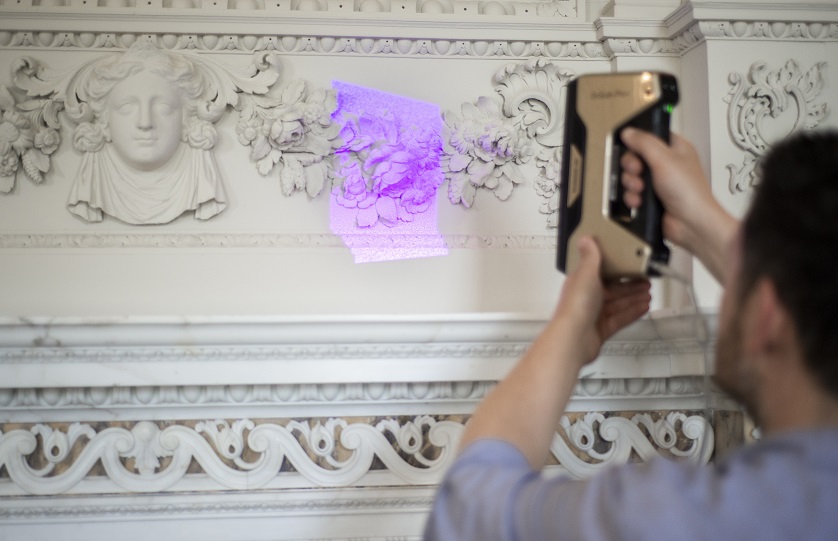
Greg Meeson of Refinery uses a handheld 3D scanner to capture the 3D form of ornate features
Digital technology offers a wealth of new possibilities, and with careful consideration they can have a positive role to play in conservation alongside traditional techniques and methods.
Rather than offering a poor substitute, it can provide an efficient platform for the continuation of historic processes.
Much time has passed since hand carving and the creation of ornate architectural features was a widespread feature of architectural design, and even its role as a conservation technique is facing fresh challenges.
With increasing skill-shortages for the conservation of historic buildings, as well as the cost and time implications of traditional processes, many conservation projects find they are without an attractive route for the repair and restoration of many features.
So, in finding modern approaches within this most ancient of traditional crafts, there is perhaps a role for digital technology to play in the continuation of conservation projects.
Far from bringing about the demise of traditional processes, it can help traditional craftspeople to meet the challenges of the modern conservation industry.
By offering a more adaptable and efficient solution in conservation projects it can preserve the longevity of ancient craftsmanship.
Case Study: Vincenzo Valdre Fire Surround, Stowe House
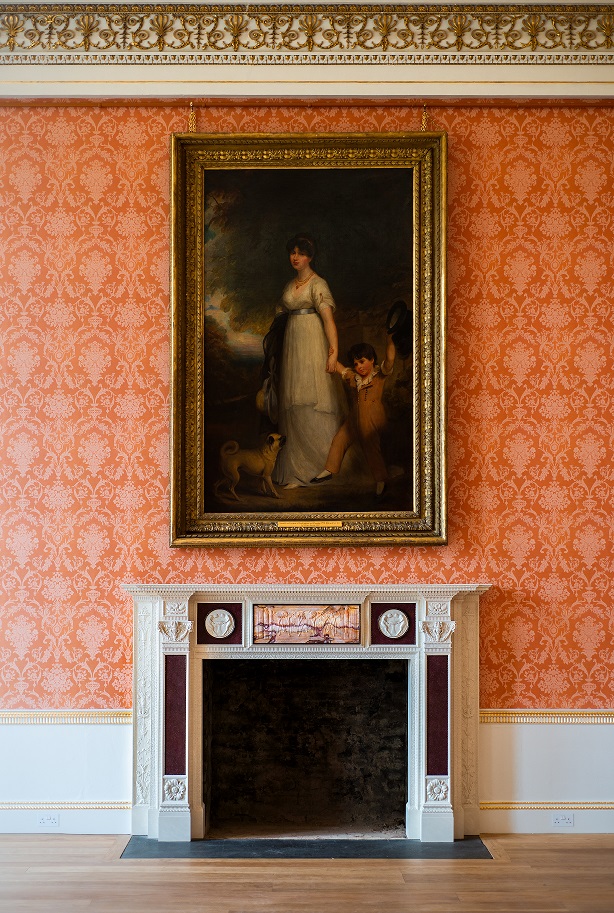 |
|
| Completed fire surround, installed in the newly restored State Drawing Room at Stowe House |
At Stowe House in Buckinghamshire, the integration of digital technology into traditional process has been used with great success in their reinstatement of an 18th century fire surround. Stowe is one of the country’s grandest 18th century houses.
Like many others, its upkeep could not be sustained in the aftermath of the first world war and, following bankruptcy, a grand auction was held in 1921. Much of Stowe House’s interior was then gutted and its contents scattered around the world.
Today the building is listed as one of the World Monuments Fund’s 100 most endangered sites of world significance, and in recent years, the Stowe House Preservation Trust has gone to great lengths to preserve and restore much of Stowe House with magnificent results.
The trust’s recent restoration of the State Drawing Room included plans to replicate the vastly ornate Vincenzo Valdré marble fire surround with bas relief inlays that once adorned the room.
This project faced considerable obstacles as the original was now residing in Spain and in very poor condition. Furthermore, recreating the highly ornate surface and fine craftsmanship of the original posed great problems as traditional production methods alone would be prohibitively expensive.
One option was to replicate it in timber, hand-painted using traditional techniques to give the appearance of the original marble. An innovative solution was put forward by Refinery a partnership formed by a traditional craftsperson and a digital production specialist.
Its proposal would reduce the costs further through the use of a digital model made from scans of the original, and the use of CNC machining to prepare the joinery for hand carving and finishing.
This combination of digitally-led production with expertise in traditional joinery and timber carving would not only make the project a practical possibility, but it also offered verifiable accuracy and efficiency, and it brought with it a wealth of new possibilities communication and client involvement.
The proposal was accepted by the client and work began in July 2020. Working with detailed scan data taken from the original fire surround, 3D modelling was used to transform this surface data into a highly accurate 3D digital production model.
This model included the full surface in fine detail, and its structure was accurately defined and was even divided into the component parts ready for construction.
The design approach was supported by an extensive knowledge of traditional joinery techniques and how wood behaves as it ages, Joinery and assembly techniques were selected that matched the original design as closely as possible and allowed the wooden structure to settle as it aged.
While this 3D digital model’s primary role would be to drive the CNC process of cutting timber, it also served more widely, yielding a wide range of benefits to other stages before production began.
Scale drawings, photo-real visualisations and 3D printed models were all used to deliver a comprehensive view of the planned work ahead of production.
It enabled a new level of understanding and involvement for the client, seeing tangible information about the project before work began.
With the digital model broken down into component parts, it also provided a visual management framework for the project, from which schedules of work for each stage of the project was created.
When production began, the many digital 3D components were each used to drive the CNC cutting of timber. Rather than attempt to replace or rival the quality and natural feel of a hand carved surface, CNC was used for the reduction of timber down to a ‘near-form’, ready to be hand carved to its final surface.
With ornate forms covering almost the entire surface, this digitally led process brought remarkable accuracy and efficiency to the project.
Hand Carving
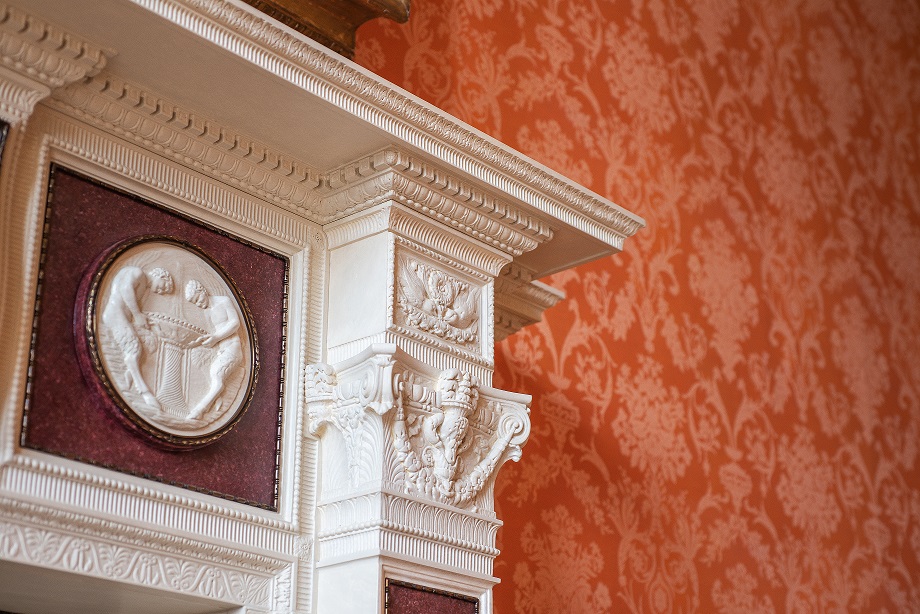 |
|
| Close up of the Stowe House fire surround showing the fine detail in the carving |
Once cut by CNC, each component part was then carefully carved by hand, using tools and process that have been used unchanged for centuries, taking it from its soft, near form to a finely detailed finish. the hand carving brings a continuity and authenticity to the work.
The result is a fully hand carved surface, with crisply defined features and a rich interplay of light and shadow across a surface that comes to life with vibrant organic quality.
Finally, the entire wooden structure was decorated with marble paint effects, giving it the appearance of marble, in keeping with the original. The accurately depiction of the central alabaster bas-relief was aided by life sized, colour accurate photographic prints of the original.
Brass frames were then applied, having been cast using traditional lost wax process, in moulds taken from 3D printed replicas of the original frames.
The result is a fire surround of exceptional quality. Its carved surface is a precise match to the original, with a finely detailed finish, rich in the visual language of traditional craft. It now forms a centrepiece to the fully restored State Drawing Room at Stowe House.
As a project, it highlights the benefits of employing digital technology within a considered approach, and it illustrates a ground-shift in our understanding of the potential uses for this technology in the repair and reinstatement of historic features in restoration projects.
The fire surround is the first completed project in Refinery’s ongoing series of works for Stowe House, and it is now working on the creation of two twin chimney pieces designed by Henry Flitcroft, for Stowe’s State Dining Room.



